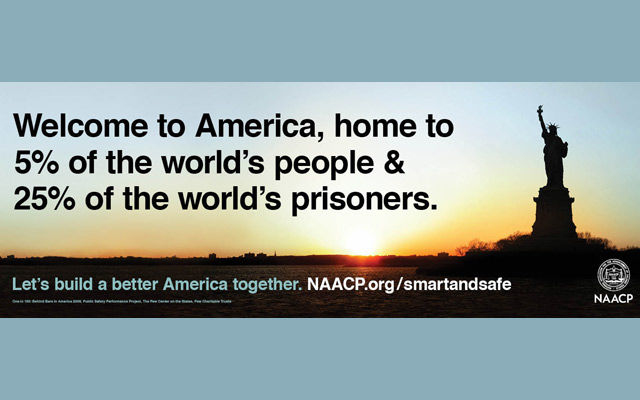
On March 28, Ruth Wilson Gilmore gave the annual Yulee Endowed Lecture, hosted by the Women’s Studies Program at the George Washington University. Her talk opened with a slide showing an NAACP billboard that said, against the Statue of Liberty as background,
Welcome to America home to
5% of the world’s people &
25% of the world’s prisoners.
This is the same America that is home to 5% of the world’s population and produces 27.8% of the world’s greenhouse gases from fossil fuel, according to the National Environment Trust.
Pollution and incarceration reveal a dreadful, man-made reality. For both prison and pollution, the United States tries to change its image rather than face up to the reality. The United States is the primary source of world pollution and of prison practices. A prison binge has been built on the disregard of women, of people of color, of the poor. High levels of pollution have been built on absurd consumerism passed off as a social good. Meanwhile, for many, these add up to a cruel reality.
United States administration after administration has produced more laws to incarcerate more people and more “Acts” to cover up the high level of emission of Green House gases and other pollutants. Images of poor people, especially of women of color, abusing the welfare became as visible as the images of the destruction of the “Commons” became invisible. What one hand giveth, the other taketh away.
In her lecture, Ruth Wilson Gilmore talked about the reality of incarceration. Her book, The Golden Gulag Prisons, Surplus, Crisis, and Opposition in Globalizing California, started as a community project: a research for Mothers ROC (Mothers Reclaiming Our Children) in California, women who know too well the reality of and reasons for incarceration. They needed “a non-lawyer activist with research skills, access to university libraries, and a big vocabulary, to help them.” Gilmore fit the bill perfectly.
In her book, Gilmore relocates the two laws that sent the Mothers’ children to prison—the Street Terrorism Enforcement and Prevention Act and the “three strikes and you’re out” law—into their historical political economic context. Ruthie, as everyone calls her, presented on the particular history of capitalism in the United States, the story of opportunity fertilized with inequality and racism. Her lecture was called “What Would Harriet Do? Unfinished Liberation or the Dangers of Innocence”.
Harriet is Harriet Tubman.
Harriet Tubman’s story exemplifies the root of the social and racial American construction. For Gilmore, Tubman was a designer and a political artist. Tubman’s story of unwavering determination to bring slaves of the south to freedom speaks directly to today’s “zero tolerance.” As the false stories told of African and African-derived people helped to justify the slavery of thousands of women, men and children of African descent, so today’s false story of “zero tolerance” attacks African Americans. 65 million people are currently banned from employment because of previous convictions, and those people live in the communities that most need steady employment.
The following day Ruth Wilson Gilmore continued the conversation in Dan Moshenberg’s Seminar, “Women In and Beyond the Global Prison.”
Again, the discussion focused on the construction of images, from the witch-hunt that put women back in the “domus,” to the “Reaganomic” image of the welfare-queen that re-segregated poor and working African American women, thereby legitimating the re-appropriation of power and global capital. Welfare-queen became pathology. To unpack that pathology, we must learn to study “the genealogy of the phrase,” and thereby reinforce the importance of historical consciousness.
Gilmore brings to light the reality of the political economic project that requires mass incarceration. That project is genocidal, and that project of mass incarceration speaks directly to the situation of health care and reproductive rights in the United States.
Slavoj Žižek recently argued, “one of the strategies of totalitarian regimes is to have legal regulations (criminal laws) so severe that, if taken literally, everyone is guilty of something. But then their full enforcement is withdrawn… At the same time the regime wields the permanent threat of disciplining its subjects.”
I am not saying that we live in a true totalitarian regime. That is not the question. The question is whether we understand that these ‘all-guilty’ laws work to control and subjugate certain sections of the population, such as the African Americans, Native Americans, immigrants, and also women. Of course, women intersect with the other “guilty” populations. In many states, laws limiting women’s reproductive rights are blossoming, and punishment and incarceration await the women who try to secure or wield their rights. At the same time, the story of Trayvon Martin’s assassination fits this framework of being eternally guilty. His corpse was tested for drugs and alcohol. His shooter never had to be tested and is still alive and free.
There are many other stories that show that the current rule of law is an active political-economic tool. Ben Saperstein and May Young, two activists from North Carolina, attended the seminar with Gilmore and Moshenberg. They were there to learn and exchange ideas for their own struggle. They are involved with the Greensboro Legal Fund, which works to bring to light the fate of members of a Latino organization that has been wrongfully accused of racketeering, and has been incarcerated for political reasons.
The exchanges among activists and scholars from North Carolina, Washington, New York and beyond showed the importance of research working with activism. In this time of neoliberal surge, as Žižek remarked, “what unites us is the same struggle”. In this struggle, Ruth Wilson Gilmore’s inspirational work reminds us of the importance of excellent scholarship as a means of resistance.
(Image Credit: NAACP)